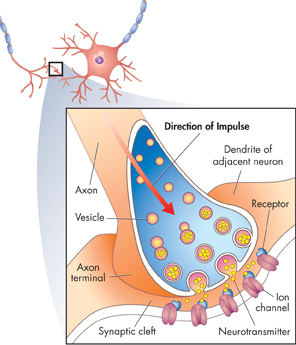
FIGURE 31–6 The Synapse When an impulse reaches the end of the axon of one neuron, neurotransmitters are released into the synaptic cleft. The neurotransmitters bind to receptors on the membrane of an adjacent cell. Apply Concepts What are three types of cells that could be on the receiving end of an impulse?
dThe Synapse At the end of the neuron, the impulse reaches an axon terminal, which may pass the impulse along to another cell. A motor neuron, for example, may pass impulses to a muscle cell, causing the muscle cell to contract. The point at which a neuron transfers an impulse to another cell is called a synapse (SIN aps). As shown in Figure 31–6, a space, called the synaptic cleft, separates the axon terminal from the adjacent cell.
The axon terminal at a synapse contains tiny vesicles filled with neurotransmitters. Neurotransmitters are chemicals that transmit an impulse across a synapse to another cell. When an impulse arrives at the synapse, neurotransmitters are released from the axon, diffuse across the synaptic cleft, and bind to receptors on the membrane of the receiving cell. This binding opens ion channels in the membrane of the receiving cell. If the stimulation exceeds the cell's threshold, a new impulse begins.
Once they have done their work, the neurotransmitters are released from the receptors on the cell surface. They are then broken down by enzymes in the synaptic cleft or taken up and recycled by the axon terminal.
31.1 Assessment

-
Review Describe the functions of the nervous system.
Apply Concepts Describe how your peripheral nervous system and central nervous system were involved in a simple activity you performed today.
-
Review Name and describe the three types of neurons.
Predict The immune system of people with multiple sclerosis attacks myelin sheaths in the central nervous system. The myelin breaks down and scar tissue may result. How do you think this would affect the transmission of signals from the central nervous system?
-
Review What happens when a neuron is stimulated by another neuron?
Infer How can the level of pain you feel vary if a stimulus causes an all-or-none response?
VISUAL THINKING
Create a flowchart to show the events that occur as a nerve impulse travels from one neuron to the next. Include as much detail as you can. Use your flowchart to explain the process to a classmate.

Table of Contents
- Formulas and Equations
- Applying Formulas and Equations
- Mean, Median, and Mode
- Estimation
- Using Measurements in Calculations
- Effects of Measurement Errors
- Accuracy
- Precision
- Comparing Accuracy and Precision
- Significant Figures
- Calculating With Significant Figures
- Scientific Notation
- Calculating With Scientific Notation
- Dimensional Analysis
- Applying Dimensional Analysis




